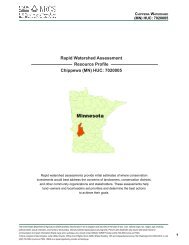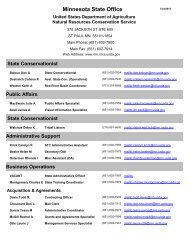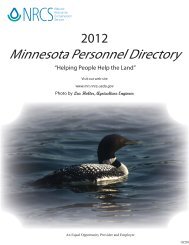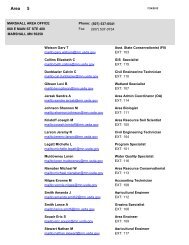Living Landscapes in Minnesota: - Minnesota NRCS - US ...
Living Landscapes in Minnesota: - Minnesota NRCS - US ...
Living Landscapes in Minnesota: - Minnesota NRCS - US ...
You also want an ePaper? Increase the reach of your titles
YUMPU automatically turns print PDFs into web optimized ePapers that Google loves.
Intermediate Care, Storage, and Handl<strong>in</strong>g of Trees and Shrubs<br />
Transport all stock <strong>in</strong> a covered vehicle to prevent desiccation of the tops<br />
and dry<strong>in</strong>g of the roots. Bareroot stock should have the roots covered with<br />
saturated (soaked <strong>in</strong> water for several hours) sh<strong>in</strong>gle tow, wood shav<strong>in</strong>gs,<br />
sphagnum moss, or shredded paper. The root cover<strong>in</strong>gs should be moist for the<br />
entire trip, but the roots should not be immersed <strong>in</strong> conta<strong>in</strong>ers of water.<br />
Bareroot plants are shipped dormant and should be planted as soon as<br />
possible, usually with<strong>in</strong> 72 hours of leav<strong>in</strong>g the nursery. For short storage <strong>in</strong>tervals<br />
(less than 3 days), bareroot plants can be kept <strong>in</strong> cool, shaded locations outdoors<br />
or <strong>in</strong> a cool basement. Cover the roots as was done for transport from the nursery.<br />
Inspect daily to ensure root cover<strong>in</strong>g rema<strong>in</strong>s moist. Make sure all the root cover<strong>in</strong>g<br />
is thoroughly saturated. It works best to soak the root cover<strong>in</strong>gs <strong>in</strong> a bucket of<br />
water before cover<strong>in</strong>g the roots. The root cover<strong>in</strong>g material should always be wet<br />
enough that a bit of water can be squeezed from a handful. Keep seedl<strong>in</strong>gs out<br />
of direct sun, and protect from w<strong>in</strong>d dessication and heat build-up. Never let the<br />
roots dry out dur<strong>in</strong>g the plant<strong>in</strong>g process, even for a few seconds. For time periods<br />
of less than an hour, bareroot trees can be transported <strong>in</strong> buckets of water dur<strong>in</strong>g<br />
the plant<strong>in</strong>g process. Do not damage roots dur<strong>in</strong>g storage or plant<strong>in</strong>g by bend<strong>in</strong>g,<br />
break<strong>in</strong>g, scrap<strong>in</strong>g bark, etc.<br />
<strong>Liv<strong>in</strong>g</strong> <strong>Landscapes</strong> <strong>in</strong> M<strong>in</strong>nesota: A GUIDE TO NATIVE PLANTSCAPING<br />
TREES AND SHRUBS<br />
19<br />
Conta<strong>in</strong>er/potted plants offer more flexibility <strong>in</strong> plant<strong>in</strong>g, handl<strong>in</strong>g, and storage<br />
than bareroot stock. The soil <strong>in</strong> the pot provides a limited amount of water storage<br />
permitt<strong>in</strong>g active growth when weather conditions permit. Check daily and water as<br />
needed to wet the entire pot. Ensure that pots have dra<strong>in</strong>age holes to allow excess<br />
water to dra<strong>in</strong>. Conta<strong>in</strong>er plants may have been potted just before purchase or they<br />
may have been grown <strong>in</strong> the pot for several seasons. Store conta<strong>in</strong>er stock <strong>in</strong> a<br />
w<strong>in</strong>d-protected area out of direct light. When plant<strong>in</strong>g, conta<strong>in</strong>er stock should be<br />
removed from the pot.<br />
Balled and Burlapped (B&B) material often requires special handl<strong>in</strong>g given<br />
the size and weight of the plant, roots, and soil. Do not move B&B plants by the<br />
trunk alone. Support the trunk and root ball simultaneously to assure the roots are<br />
not broken at the trunk surface. Never drop a B&B plant abruptly on the ground,<br />
even from a slight elevation. Gently slide or roll large B&B plants <strong>in</strong>to the plant<strong>in</strong>g<br />
hole. Never attempt to move an excessively wet root ball. Store B&B material as you<br />
would conta<strong>in</strong>er plants. Media such as a sand/peat mix may be used to cover the<br />
root ball dur<strong>in</strong>g long-term storage. Special provisions may be needed to secure the<br />
plants dur<strong>in</strong>g storage <strong>in</strong> high w<strong>in</strong>d locations.






